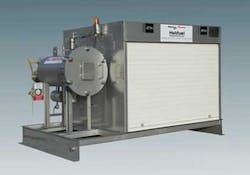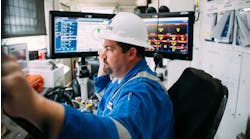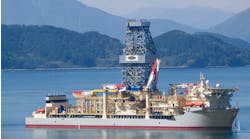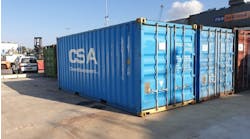Industry needs guidance to comply with helicopter regulations
Nick Terdre, Contributing Editor
Regulations for helicopter refueling systems offshore are evolving constantly. Keeping abreast of the changes is a priority for Helifuel, according to managing director Oddvar Østensvik.
Helifuel supplies a full range of maritime helicopter refueling systems and associated services, including commissioning support, maintenance and upgrading services, and personnel training. The company supplies only maritime helicopter refueling systems, with the offshore sector as its main customer, though it also sells to the shipping industry and military sector.
Based at Sveio outside Haugesund in western Norway, it has an international network of agents. It carries a full range of stocks in both Haugesund and Houston, where it is represented by Specific Equipment Co. This includes a full helicopter refueling system for immediate delivery. The company makes its equipment available for rent as well as purchase.
The issue of regulatory compliance is a demanding one, Østensvik explains. There is no single set of regulations to abide by. In the case of rigs and ships, there are requirements set by the relevant classification society, but each society applies its own selection of requirements. Local rules and regulations apply as well.
In this rather confusing situation, the industry has chosen to take as a voluntary standard the regulations entitledOffshore Helicopter Landing Areas, Guidance on Standards (UK sector). Known as CAP 437, these regulations are revised regularly, which is why it is important to keep up to date.
A full refueling system comprises a laydown skid, fuel tanks, a pump unit, a dispensing unit, and a deluge system to protect the tank in case of fire. The company has DNV type-approval for the complete system, and is working to get type-approval from other classification societies.
20,000 liter deliveries
Helifuel supplies both standard models and tailor-made systems. For storage the standard delivery is a pair of 2,900-liter (766-gal) capacity transportable tanks - when one tank is empty it is returned to shore to be refilled while the fuel in the other tank is used. In case of installations with a heavy refueling demand, fixed tanks of up to 20,000-liter (5,283-gal) capacity can be supplied.
The company uses equipment basically made of 316L stainless steel, which therefore lasts the lifetime of the installation it goes to. It buys in most components and assembles the systems. Full factory acceptance testing always is performed before any equipment is delivered. There are more employees engaged on engineering than on building and assembling systems. There is also a focus on low weight, with the use of alternative materials and alternative technical solutions. The deluge system, for example, can be supplied in titanium or GRP materials.
Helifuel also supplies recycle units, which makes it possible to return to the tank the fuel samples that must be taken regularly. This is a worthwhile investment for the customer, as anything from 10,000 to 30,000 liters (2,641 to 7,925 gal) of fuel might be sampled over a year. The recycle system works without any fuel being manually handled - regular exposure to fuel can be damaging to human health. The sampled fuel is routed into the recycle tank, where it settles, and is then passed through a filter before being returned to the tank.
Critical components in the dispenser unit are the filters. These form part of the filter separator (API 1581 standard), which separates out water and particles, and the filter monitor (API 1583), which absorbs water and automatically shuts down fuel delivery if the water content is too high. Helifuel uses only filters from manufacturers which guarantee that their products have been tested to the relevant API 1581 specification - as far as the company knows, there are only three companies in the world which can meet API 1581.
Also part of the product range are in-flight refueling systems, for refueling helicopters on vessels where they are unable to land.
Since it started up in 1996, Helifuel has delivered a total of 150 refueling systems, according to marketing manager Jorunn Håvardsholm. “As far as we know, they are all still in operation, we sell very few spare parts,” she says.
Among the company’s recent deliveries and current orders are Marathon’sAlvheim FPSO, Aker Kvaerner’s Smart FPSO, Total’s Dalia FPSO (through Technip), two systems to Fluor Daniel for a ConocoPhillips field development in Bohai Bay, China, and two systems each to Mosvold Drilling, Seadrill Offshore, and Aker Drilling for newbuild drilling rigs.
It also has several frame agreements for service and maintenance, with customers such as Statoil, ConocoPhillips in the North Sea and China, Shell in Nigeria, Stena Drilling, and several other drilling rigs operators.
Østensvik notes that many customers come back to the company with new orders, an indication, he feels, that they share Helifuel’s concern for high HSE values. The company also benefits from maintaining close contact with its customers. “We get good feedback from operators, we learn a lot from them,” he says.
Helifuel runs courses in operating refueling systems both in-house and at training schools in Norway, and has its own refueling simulator for this purpose.




